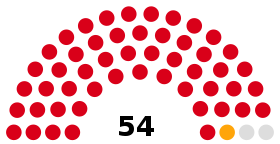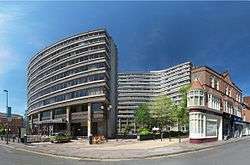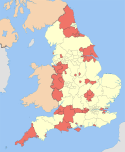Leicester City Council
Leicester City Council is a unitary authority responsible for local government in the city of Leicester, England. It consists of 54 councillors, representing 22 wards in the city, overseen by a directly elected mayor. It is currently controlled by the Labour Party and has been led by Mayor Sir Peter Soulsby since his election on 6 May 2011. The main council building is City Hall on Charles Street, but council meetings are held in the 19th-century Town Hall.
Leicester City Council | |
|---|---|
| Executive mayor elected every four years Whole council elected every four years | |
 Coat of arms | |
 Council logo | |
| Type | |
| Type | |
| History | |
| Founded | 1 April 1974 |
| Leadership | |
Lord Mayor | Cllr Annette Byrne since 16 May 2019 |
City Mayor | Sir Peter Soulsby, Labour since 6 May 2011 |
Chief operating officer | Andy Keeling |
| Structure | |
| Seats | 1 executive mayor 54 councillors[1] |
 | |
Council political groups |
|
| Elections | |
Council voting system | Plurality-at-large |
Mayor voting system | Supplementary vote |
Council last election | 2 May 2019 |
Council next election | 4 May 2023 |
| Website | |
| www | |


As a unitary authority, the council is responsible for running nearly all local services in Leicester with the exception of the Leicestershire Fire and Rescue Service and Leicestershire Constabulary which are run by joint boards with Leicestershire County Council and Rutland County Council.
History
The Council traces its roots to the Corporation of Leicester, and before then to the Merchant Gild and the Portmanmoot. The Portmanmoot consisted of 24 Jurats, elected from the burgesses (members of the Gild Merchant, or freemen), along with two bailiffs, and a clerk. It appears to have existed before the Norman Conquest in 1066. In 1209, the lead member of the Portmanmoot, the Alderman, became known as a mayor. The Gild Merchant and the Moot overlapped in membership and had probably become effectively merged in the 14th century. Membership of the Twenty-Four appears to have been by co-option, chosen by themselves.
Traditionally, the general populace attended some meetings of the Moot and Guild, but this was restricted to burgesses in 1467. Later, in 1489, this changed to a system where the Mayor and the Twenty-Four chose Forty-Eight burgesses to represent the others, and the Twenty-Four and the Forty-Eight would govern jointly.
After doubts as to the ability of the Moot and Gild to hold property arose in the 16th century, the Corporation was formed, replacing the Gild and Portmanmoot, in 1589. A second charter was granted in 1599, reconfirming this, to The Mayor, Bailiffs and Burgesses of the Borough of Leicester. The 24 Jurats became known as the Aldermen of the Corporation, and the 48 other Burgesses as the Common Council. The members of the Corporation chose the burgesses to send to the House of Commons.
The Corporation, as with most English municipal corporations, continued effectively unreformed until the Municipal Reform Act of 1835, although the freemen in general obtained the right to participate in the election of MPs after the Restoration. The Municipal Reform Act replaced the existing system of co-option for members of the council with elections by rate-payers. This led to a prolonged spell of Liberal control of the council.
Leicester became, in 1889, under the Local Government Act, a county borough. The Corporation was replaced in 1974 under the Local Government Act 1972, with the modern Leicester City Council, a non-metropolitan district council under Leicestershire County Council. Leicestershire County Council's jurisdiction over the City of Leicester was transferred to the City Council on 1 April 1997, making it a unitary authority, as part of the 1990s UK local government reform.
Lord Mayor
The position of Lord Mayor of Leicester is mainly a ceremonial post, and is combined with that of chairman of the council. The position is elected yearly by members of the council and rotates.
Wards
The City is divided into 21 electoral wards, each of which returns two or three councillors, using the bloc voting system, as follows:[5]
| Ward | Councillors | Notes |
|---|---|---|
| Abbey | 3 | from Abbey Park up to Stocking Farm and Mowmacre Hill |
| Aylestone | 2 | Aylestone Village, Gilmorton estate, part of Aylestone Park, Aylestone Meadows, one side of Saffron Lane from the Porkpie roundabout to Knighton Lane and Aylestone Road/Lutterworth Road from Grace Road to the county border at Glen Parva. |
| Beaumont Leys | 3 | |
| Belgrave | 3 | most of the Belgrave area |
| Braunstone Park & Rowley Fields | 3 | including most of Braunstone |
| Castle | 3 | city centre, Southfields, Clarendon Park |
| Evington | 3 | |
| Eyres Monsell | 2 | |
| Fosse | 2 | |
| Humberstone & Hamilton | 3 | including Nether Hall |
| Knighton | 3 | |
| North Evington | 3 | |
| Rushey Mead | 3 | Includes parts of the Belgrave area including Agar Street. |
| Saffron | 2 | |
| Spinney Hills | 2 | including parts of Highfields |
| Stoneygate | 3 | also including parts of Highfields |
| Thurncourt | 2 | The Thurnby Lodge estate |
| Troon | 2 | The Northfields estate, parts of the former Charnwood ward and a small part of the Rushey Mead area |
| Westcotes | 2 | |
| Western | 3 | The New Parks estate |
| Wycliffe | 2 | St Matthew's estate and part of Highfields |
A new set of wards and ward boundaries came into effect for the 7 May 2015 council elections. Wards that previously existed and were abolished are Charnwood, Coleman, Freeman, Latimer, New Parks and Western Park.
The previous ward boundaries were adopted for the 2003 local elections.[6] Prior to this, there had been 28 wards, each electing 2 members. Wards that had existed and been abolished were Crown Hills, East Knighton, Mowmacre, North Braunstone, Rowley Fields, Saffron, St Augustine's, West Humberstone, West Knighton and Wycliffe.
Political control
The current composition of the council is as follows:
| Party | Seats[7] | |
|---|---|---|
| Labour | 51[n 1] | |
| Independent | 1[n 3] | |
| Liberal Democrats | 1 | |
| Vacant | 1 [n 2] | |
The Council had been under the control of the Labour Party from 1979 until the 2003 local elections, where no overall control was established. Labour regained control in 2007 and consolidated its position in 2011.
In December 2010 the Council voted to introduce a directly elected mayor with effect from May 2011. On 5 May 2011 Sir Peter Soulsby was elected to the post with 55% of the vote on the first ballot. He was re-elected in May 2015 and 2019 to serve four-year terms.
Veejay Patel was the last Leader of the Council until May 2011, having replaced Ross Willmott on 25 March 2010. Councillor Willmott served three spells as Leader: from May 1999 to May 2003; from November 2004 to May 2005; and from May 2007 to March 2010.
The council was under no overall control between 2003 and 2007. A Liberal Democrat-Conservative administration controlled the council from May 2003 until it collapsed in November 2004, after which a Labour minority administration took power.[8] The Liberal Democrat-Conservative administration re-grouped in 2005 and controlled the council until May 2007 when Labour returned to power, consolidated its position still further in May 2011, 2015 and 2019 when the Conservative Party lost its only councillor.[7]
As of May 2019, the Council is composed of 53 Labour councillors, plus the directly elected mayor, who is eligible to take part and vote in Council meetings and one Liberal Democrat councillor.[7]
The next election is due to take place in May 2023,[9] although by-elections take place when a seat becomes vacant due to resignation or death of a councillor.
Leadership
Incompletent list of council leaders:
- Jim Marshall (1973–74)
- Michael Cufflin, Conservative (1974-79)
- Ken Middleton (1979–81)
- Peter Soulsby (1981–94)
- Stuart Foster (1994–96)
- Peter Soulsby (1996–99)
- Ross Willmott (1999–2003
- Roger Blackmore (2003–04)
- Ross Willmott (2004–05)
- Roger Blackmore (2005–07)
- Ross Willmott (2007–2010)
- Veejay Patel (2010–2011)
- Peter Soulsby (2011–present, directly elected mayor)
Elections
Previous results of elections to the city council:
| Overall control | Labour | Conservative | Lib Dem | Green | |
| 2019 | Labour | 53 | - | 1 | – |
| 2015 | Labour | 52 | 1 | 1 | – |
| 2011 | Labour | 52 | 1 | 1 | – |
| 2007 | Labour | 38 | 8 | 6 | 2 |
| 2003 | No overall control | 20 | 9 | 25 | – |
| 1999 | Labour | 30 | 10 | 16 | – |
| 1996 | Labour | 41 | 7 | 8 | – |
| 1995 | Labour | 45 | 4 | 7 | – |
| 1991 | Labour | – | – | – | – |
| 1987 | Labour | – | – | – | – |
| 1983 | Labour | – | – | – | – |
| 1979 | Labour | – | – | – | – |
| 1976 | Conservative | 21 | 27 | – | – |
| 1973 | Labour | 37 | 11 | – | – |
The May 1996 elections were held out of sequence because of the upcoming unitary authority status, which came into effect on 1 April 1997.
Notes
- Assistant Mayor Mustafa Malik was suspended from the Labour Party on the 22nd of November, 2019, to be investigated for anti-semitic social media posts. However, he has been allowed to continue to sit as a Labour Councillor. [2]
- Evington Councillor Jean Khote died on the 14th of February, 2020. The Writ of By-Election is yet to be moved. [3]
- Cllr. John Thomas resigned from the Labour Party on the 18th of November, 2019, after the selection of Claudia Webbe as the Labour Leicester East candidate for the 2019 United Kingdom general election[4]
References
- http://opencouncildata.co.uk/council.php?c=343&y=0
- Martin, Dan (22 November 2019). "Top Labour councillor suspended over anti-Semitic KKK video". Leicester Mercury. Retrieved 22 November 2019.
- Martin, Dan (15 November 2019). "Dedicated and popular Labour Leicester councillor Jean Khote dies". Leicester Mercury. Retrieved 22 February 2020.
- "Leicester East Labour chairman quits 'laughing stock' party". BBC News. 18 November 2019. Retrieved 22 November 2019.
- Local Government Boundary Commission for England. "Leicester (Electoral Changes) Order 2014". www.lgbce.org.uk. Archived from the original on 18 April 2015. Retrieved 30 March 2015.
- Local Government Boundary Commission for England. "Electoral review of Leicester 2002". www.lgbce.org.uk. Archived from the original on 18 April 2015. Retrieved 30 March 2015.
- "Leicester City Council". BBC News.
- "Labour snatches council control". BBC News. 26 November 2004.
- Keith Adkins. "UK Local Government Information - Trailor 2019". uklocalgov. Retrieved 25 January 2017.
